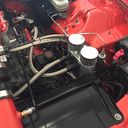5027 Homestead, IN 46814 USA
CNC/Weld Hours
Monday — Friday
10am -3pm
Saturday
Closed
Sunday
Closed
Welcome to RaceCatchCan.
Yay! 10,000 plus Facebook followers! Thanks everyone.
Building tanks, reservoirs, and oil catch cans for any application.
April 25, 2022.
Instagram--> @turbocharger
Shipping faster again. 5-10 day delay on shipment. Contact neukin@gmail.com or quick text to 260 220 8577 for any update or questions.
Over 1000 welded here in Fort Wayne Indiana. Im Aerospace certified in TIG and love to build parts. These tanks are a side project and usually only get 1 out a day for individuals. More custom needs are always a option.
Over 10,000 strong on Facebook check out the pictures posted by our customers!
Oil catch cans simply catch oil out of the block or valve cover which was sprayed out from crankcase pressure or burnt air/fuel/combustion past the piston rings. Sometimes some pressure might also leak past valve stem seals. Breather oil catch cans or breather tanks vent into the atmosphere, its not a filter as much as its just a breather but if you see a filter like element is venting crankcase pressure. If the fittings are big enough it helps prevent crankcase pressure and it is an easy affordable way of venting and making great power. This way you can still catch alot of the oil and keep the engine clean by recycling the oil with your oil change collection. Those running E85 often catch far more fuel water mixture that can even be flammable in the catch can. Using a air pump on a breather oil catch can is common on high hardcore hp situations. Creating 12hg of vac on the rings helps them seat and more power can be made by helping the seal and preventing additional crankcase pressure. The breather oil catch can is still needed after the pump. This is best also as your not sending oil combustion air lacking oxygen back into the intake. Oil separators are more complex oil catch cans. They actually try to separate or capture atomized oil fragments in the CAN and allow vac or the burnt air back into the intake. Just like air compressor oil/water separators catching foreign elements is prime. The CFM of a engine separator is much higher though as the vac from engine and crankcase pressure exceeds flow rates in cheap air compressor designs. Oil separators are best for emissions on legal road cars. Oil separators are only as good as they are engineered. Your still sending air lacking oxygen back into the motor. Some oil residue is still going to make it into the intake. At startup on a colder day the venting into the catch can can cause the vapor to condensate inside the catch can catching a water fuel mixture in your collected oil. We developed a heated 12v element to warm the catch can at start up to help prevent this. Those running E85 often catch far more fuel water mixture that can even be flammable in the catch can. A race oil catch can vents through the breather. With 4 large -12an fittings venting enough for 1000hp can be achieved or generally two -16an, though very dependent on engine condition and other variables. Doing so though results in splashed oil exiting the vents. The oil catch can is baffled to help prevent oil from exiting the breather elements. In very hardcore situations a air pump can be ran to create 12hg of vac to help set rings and gain some power. From the air pump into a breather catch can then. The stock system was never developed for racing and higher hp so it must be upgraded and routing changed. The stock bung on the valve cover is normally baffled in the cover to prevent oil from exiting. Sometimes even if you use the stock valve cover breather hole oil fragments will exit and enter the intake or exit on your engine or ground depending on your setup. Oil drips are not looked at with pleasure from your raceway. If using a oil separator catch can on a low hp turbo street engine putting nipple on your intake between the air filter and turbo is best. This nipple creates some vacuum helping to suck old air out of the valve cover and crank case. This if for race but also street applications. Its normal to weld two bungs to the valve cover. Those bungs are not baffled and catch alot of oil. If you are going this route you will want the race catchcan as its volume is larger and intended for more airflow. Has bracket welded on back for easy install. -10an fittings on top Two -10an bungs for valvecover -6an fitting on bottom for drain -6an cap for drain. Optional you will need two 3ft sections of stainless line for -10 and usually two 90 degree -10an push on fitting.. two straight -10an push on fittings. You may find it good to use two 45 degree -10an fittings in some cases.
Awesome quality and by far the cleanest looking catch can out there. Thanks again..

5027 Homestead, IN 46814 USA
CNC/Weld Hours
Monday — Friday
10am -3pm
Saturday
Closed
Sunday
Closed